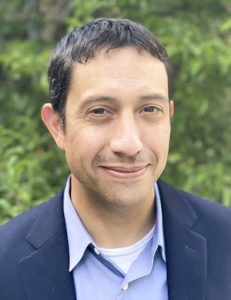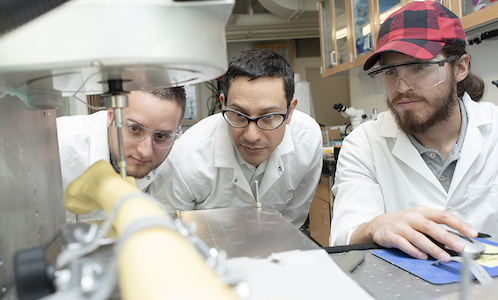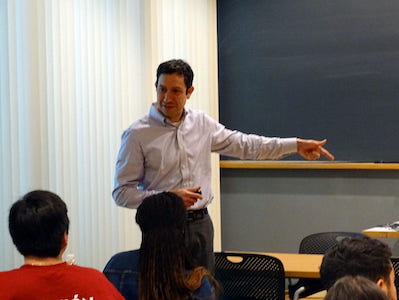ASEE CDEI Scholar Spotlight Series: Dr. Christopher Hernandez
 Dr. Christopher Hernandez
Dr. Christopher Hernandez
Dr. Hernandez is a Professor in the Departments of Bioengineering and Therapeutic Sciences and Orthopaedic Surgery at the University of California, San Francisco. Previously Dr. Hernandez served as Professor of Mechanical and Aerospace Engineering at Cornell University and Case Western Reserve University. Dr. Hernandez is a Fellow of the American Institute for Medical and Biological Engineering (AIMBE), the American Society of Mechanical Engineers (ASME), and the Biomedical Engineering Society (BMES). He is the 2018 recipient of the Fuller Albright Award for Scientific Excellence from the American Society for Bone and Mineral Research. In 2022 he was named to the inaugural class of BRITE Fellows by the National Science Foundation. He has served on the Board of Directors of the Orthopaedic Research Society and is currently serving as Councilor to the American Society for Bone and Mineral Research. In 2021 he was awarded “Educator of the Year” by the Society of Hispanic Professional Engineers. His laboratory’s research currently focuses on the effects of the microbiome on the musculoskeletal system and orthopaedic surgery, the biomechanics and mechanobiology of bacteria and engineered living materials.
Tell us your story of belongingness.
My interest in DEI in science and engineering is personal. I am the grandson of a Mexican migrant farm worker. As a child my father picked fruits after school and on weekends to help the family finances. Both my parents were first generation college students and community college transfers to the California State University system. I grew up in the California Central Valley, a region with an agriculture-based economy and a sizable portion of Mexican migrant farm workers. The US born children of those workers were my classmates, and I saw the roadblocks they faced, especially those with the talent and interest in pursuing careers in engineering.
Thanks to an excellent public school system and magnet educational program in my hometown (Fresno, California), I was well prepared for the technical components of a bachelor’s degree program in engineering. Managing the social environment was more challenging, especially when it came to understanding what was expected as I progressed professionally and competition became greater.
My DEI efforts started ramping up when I was in graduate school and I joined the student chapter of the Society of Hispanic Professional engineers so that I could help the undergraduates at my institution. After establishing my laboratory I became much more active with engineering affinity groups (I was a faculty advisor for the Case Western Reserve University NSBE chapter) and recruiting undergraduate students into my laboratory. It is not unusual for my laboratory demographics to be over 50% students from underrepresented groups.
I have told my own personal story on being a Latino in engineering in a TEDx talk and in an essay in Science.

Christopher J. Hernandez Cornell Engineering by Robyn Wishna 2019
Describe your understanding of DEI and why it is essential to what you do.
Diversity, Equity and Inclusion is about creating an educational and work environment in which people from all aspects of American society are able to thrive. This involves changing the way we do business so that the playing field is more level in education and the workforce. Additionally, DEI work focuses on creating a welcoming environment in education and the workforce so that people from all backgrounds are able to do the best work.
Briefly explain the current initiatives that you are doing towards DEI.
Role models, people from similar backgrounds who have overcome challenges, provide examples of success to minoritized students and enhance resilience during the inevitable setbacks. For many minoritized students, faculty are among the first engineers they have ever met, and the availability of URM engineering faculty are their only professional role models. However, there are relatively few Hispanic engineering faculty in the US, and of those, only 10% were born in the 50 states and have direct experience with the challenges faced by US-born students. I am currently working to organize a professional development network and conference for Latino engineering faculty. Our goal is to enhance faculty teaching and research skills in a way that broadens participation by members of traditionally underrepresented groups.
I try to make impact within my professional scientific societies as well as through service to the Society of Hispanic Professional Engineers.
 What do you see as the next steps for your DEI work?
What do you see as the next steps for your DEI work?
The goal of my broadening participation efforts is to make the term “under-represented minority” obsolete in engineering. I have focused my efforts on the faculty/research pipeline because each additional Hispanic faculty member can be a role model for hundreds to thousands of students during their careers. Current trends suggest that Latinos will reach parity in engineering degrees by 2050, but we think that with energized Latino engineering faculty, our country will be able to achieve that goal by 2040. Wouldn’t it be great if we could remove Latinos from the list of groups underrepresented in engineering? What could we learn from these efforts to make similar improvements for other underrepresented groups?
What recommendations do you have for engineering educators to start incorporating social justice topics in their classrooms?
The number one thing we can do as educators is to formally address the “hidden curriculum” for our students. Professional development that explicitly describes expectations in the college or university space is key for students from underrepresented groups and also helps students from all backgrounds. The business research community has shown time and again that more diverse teams/companies perform better and that equity and inclusion enhance team member performance and retention.
What resource can you recommend to people who want to learn more about DEI in your field?
I’m not a social scientist so my primary resources start with my institutional DEI programs. I have been greatly influenced by some of the recent computational social science work focused on the role of sex and ethnicity in scientific publications and professional progress, including:
The Diversity Innovation Paradox
Diversifying the Professoriate
Topic choice contributes to the lower rate of NIH awards to African-American/black scientists
Race, Ethnicity and NIH Research Awards
Connect with our scholar
Volunteer Webmaster: Sarah Lester, California Polytechnic State University
ASEE CDEI Spotlight Committee Volunteers
Editors: Baishakhi Bose, Marsha C. Kowal and Dennis Parnell Jr.,
Getting involved with CDEI
- If you want to recommend someone for our Spotlight series click here.
- Check out website Highlights:
- Resources
- Past Blogs and Events
- Compilation of Newsletters and Reports
- Connect with the committee:
- Become a Friend of the Committee
- Follow us and tag us on Twitter
- Become a volunteer on our Communications Committee! We are always looking for people that want to share or improve their writing and leadership skills.

